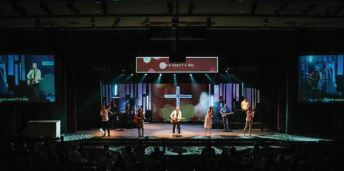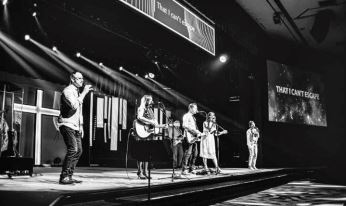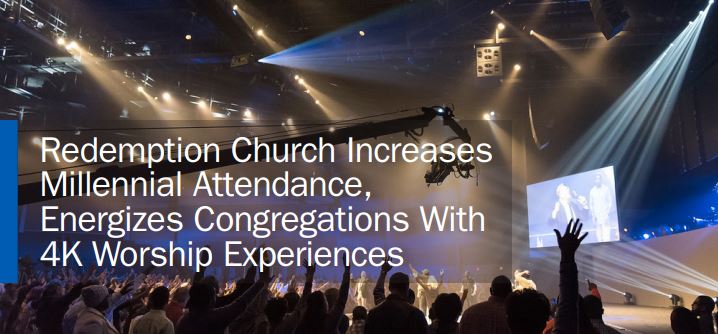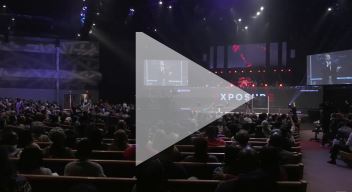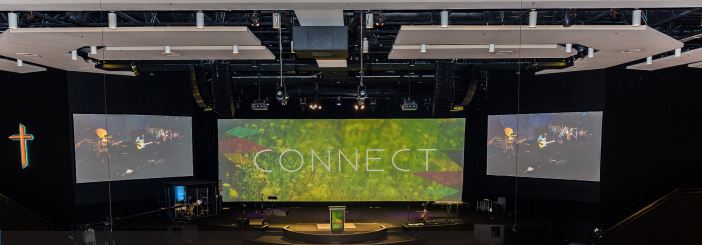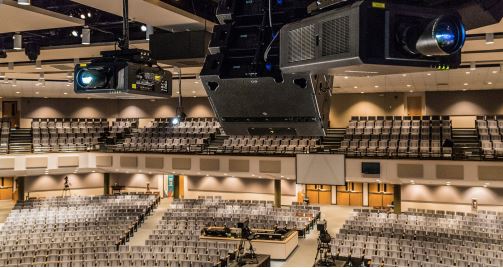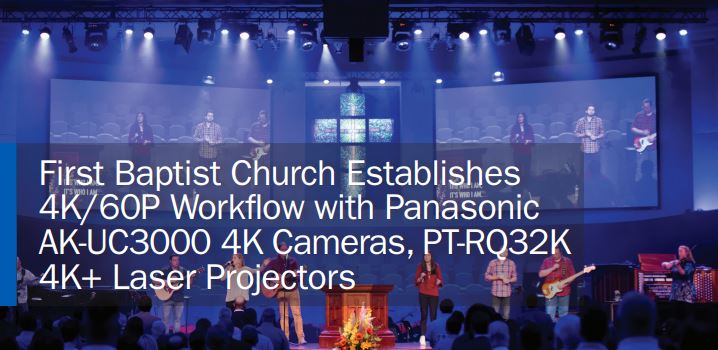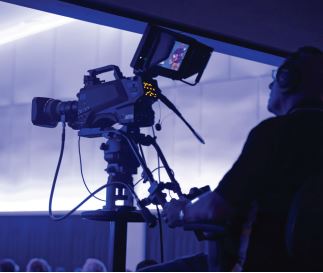September 4, 2018
20 min read
Created in partnership with AVNetwork, this ebook examines the business, TCO and resource management issues of the unique House of Worship market, focused on the rising trend of video-powered worship services and featuring case studies from the most sophisticated users and AV providers. The House of Worship Market– the Confluence of Technical and Demographic Trends […]
Read eBookCreated in partnership with AVNetwork, this ebook examines the business, TCO and resource management issues of the unique House of Worship market, focused on the rising trend of video-powered worship services and featuring case studies from the most sophisticated users and AV providers.
The House of Worship Market–
the Confluence of Technical and Demographic Trends Like no Other Market
There is much official data and many case studies on technology for houses of worship (HOW). But I’ll never forget when, years ago, a top marketing exec from a major equipment manufacturer told me a story that brought home more than facts and figures could, how important the HOW market is. He said that he and his marketing team were hosting the higher-up execs from the home office in Japan who were visiting the U.S. HQ in southern California. They were all discussing the church market, but no matter how they parsed it, the big bosses could understand the numbers in an abstract way, but where not seeing the picture clearly. Finally, the U.S. head of marketing said, “let’s go out to lunch.” They did. The exec said to the visiting team “pick a direction- north, south, east or west- I’ll head in that direction, and I want you to count all the churches we pass.”
The execs counted more churches than they had guessed would be within a 20 mile radius. An object lesson, on the ground, for anyone involved in AV or broadcast technology. Market data shows that more than half of attendees in the United States go to churches that are larger than 500 weekly worshippers in size. That is in addition to another 3,000+ churches with more than 2,000 people in weekly attendance. In those churches, AV is no longer a luxury. Of the 8,000 multisite churches in the U.S., 57 percent of them will launch an additional campus in the next 12 months and spend, collectively, more than half a billion dollars on technology for those new multi-site venues.
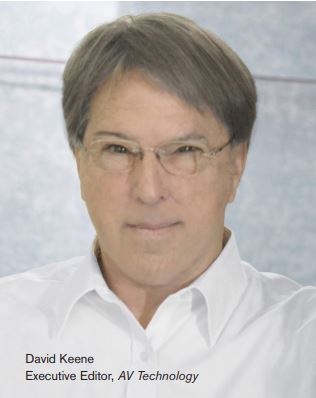
The bottom line is that the House of Worship market is one of the best growth areas for your firm’s audio, video, and lighting technology. And there is a trend to a more connected church, where shared media content and unified AVL systems are required for the demanding performance needs of a highly coordinated effort amongst professional staff and the volunteers that typically contribute greatly to a church’s staff.
There is an incredible amount of energy in houses of worship across the country– when it comes to bringing new generation technology to the task of advancing, well, joy, in the worship space. In this eBook, we look at the business, TCO, and resource management issues in this unique market and help tell that joyful story with case studies from the most sophisticated users and providers– such as Panasonic, who supports top integrators with new video tools that are taking resolution, performance, and the TCO efficiencies of video tools to new levels.
Uplifting Upgrade
Taming Acoustics with Scalable Diversity
By Bennett Liles
It’s an interesting experience when an AV contractor is called back to a church to upgrade an audio system that they installed fifteen years before. CCI Solutions was called back to Calvary Community Church in Sumner, Washington to modernize and upgrade that system. I spoke to Duke DeJong of CCI Solutions to find out the challenges, and solutions, that manifested themselves in the project.
Bennett Liles: It’s been a while since we talked, tell us first what’s been going on at CCI Solutions.
Duke DeJong: Well, funny enough a lot of Calvary churches. This is one of somewhere in the neighborhood of ten Calvary churches we’re working with right now, so trying to keep them all straight has been fun. But we just continue to help churches all over the country with audio, video, lighting, and acoustics and try to help them really connect well with people. And as you know, a lot of churches are struggling with old systems or poor acoustics– and their primary role is to communicate with people! So we have a lot of work to do with churches all over the place trying to help them communicate well with people in the room.
Do you find that churches have problems that tend to repeat?
There definitely is a lot of consistency. We can pretty quickly walk into a room and tell when it was built with most denominations because they ended up using the same architect who created a lot of the same problems. But you know, I think the biggest challenge as a whole with churches in general is they’re always trying to fight the stewardship concept of how can we maximize every dollar we’re spending and how do we be extremely efficient? And all of those things inherently are good things. It’s just one of those things where they have such high expectations and want so much, but the budget often isn’t quite there when it’s all based on donations. And always finding solutions that deliver good results at a very fair and reasonable price point is kind of the name of the game for us.
CCI Solutions was able to take down some very, very large loudspeaker boxes and replace them with these ARCS WiFO arrays. Cutting that footprint down, made lighting and projection easier to manage in the space.
So in this particular case, it wasn’t a brand new sanctuary where you might even get in on the building plans at the very beginning. You had to take out your old system first.
You know, a lot of times when we do a retrofit we kind of have to allow for a little bit of time for discovery to find out what we don’t know as we start to get in there. With these guys, though, we had a distinct advantage because 15 years ago or so, their PA was put in by us. So they were overdue for an upgrade, but the same guy who was our project manager at the time and one of our lead installers at the time were able to work on this project again. So the unknown was not a big topic for us this time. It’s a church that’s grown a lot over the last decade or two and definitely changed its style and its approach. Their services definitely have more of a rock worship type of feel, they’ve got some really dynamic speaking, and their needs have changed dramatically from where they were 15 years ago. So it was time. It was time to bring in a system that would really hang in there with the performances and the content they were throwing at it, and cover the room with not just good clarity but also warmth and fullness all the way down to the sub frequencies so they could really rock that room when they want to.
How well had you documented everything, especially after that much time has passed.
You know, that’s always entertaining for us. We’ll have churches we worked on 20 years ago reach out to us and somewhere out in a warehouse we have boxes of all those files and documentation. We’ve tried to be good over the years of scanning some of the old stuff in, but some of that we just never got to and it’s still out there in a box. So out of our 41-year history we’ve got a pretty good history of documentation and as-builts, and a very poor history of cleaning out the closets. We still own most of that stuff. Can’t always find it quickly, but we usually find it eventually.
Is this church a converted gymnasium?
Yeah, it was really kind of the ultimate multipurpose room. I mean, even today they use it for many different functions. They’ll use it for everything from a conference center to, of course, their weekend worship. I don’t believe they’re using it much for sports any more, but when they built it, it was everything. It was a gym during the week. It was conference center. So it’s definitely still got that gym look and feel to it – in fact, I believe some of the baskets are still up.
I looked at a video of this place. They don’t appear to use a podium like a more traditional church. They have mikes moving around and you never know where they might be.
And they’ve got some really great pastors on staff, very dynamic communicators. And because they are a multi-venue church, they’ve got sites in different parts of the Seattle area. Video is really important to them, so I think their staff tends to be good about staying up on the stage, but I bet during some of these events where they’re not video casting these things out, they’re down on the floor walking amongst the people.
You used the L-Acoustics ARCS WIFO speaker system and their scalable directivity must have helped get things right for the new setup.
It did. You know, for us, we love the L-Acoustics product. There’s just a warmth and a clarity to those and just such great balance that we know that any customer who gets with an L-Acoustics system is going to be happy with how it sounds. So from there it’s just a matter of what’s going to cover their room and provide for us a plus or minus three decibel coverage throughout the entire seating space. And what the ARCS WiFO system allows us to do from front to back coverage-wise is just fantastic. I mean, we are consistently able to throw those speakers into rooms that are 500-1,000 seats and really, really get just fantastic coverage from top to bottom. And the way the Wide and the Focus boxes work together, it just really gives us great coverage.
I noticed that they have a lot of projection around the stage in there. Has all of that been added since the original sound system was put in?
Oh no, that’s definitely something that’s been new in the last few years. The great news is 15 years ago speaker systems were much, much larger in general than they are today. And so the speakers that we took out of there were very large. In fact, they’ve been very affectionately named by our team “the refrigerators.” I think they were all roughly the size of a refrigerator each. But those were a custom-built cabinet that we used to make a couple of decades ago. And so really we were able to take down some very, very large boxes and replace them with these ARCS WiFO arrays. We’ve actually cut their footprint down, which is making their lighting and projection able to work easier in that space.
Sometimes the contractor has to get a little creative in where they have to locate the amps and control. Had things changed in terms of where you could locate the amp rack and that stuff?
Fortunately with this one we already had a pre-set amp rack backstage and really it was just a matter of updating the equipment in it. Taking out the old stuff and putting in the new L-Acoustics amplifiers and the Symetrix DSP. And so by and large this one was a pretty easy one as far as implementation goes. We had a great design. Everything looked good on paper. We actually own a small demo rig for the ARCS WIFO and we were able to bring that out and let the church team get in front of it and listen to it. And they just fell in love with it and within a few months we had the new rig in and everybody has been really happy.
A complicating factor on church installs usually seems to be the quick timeframe.
One of the challenges we always have in working with churches is Sunday is always coming soon, so with a project like this we’ve always got to get things done between Sundays. On a larger project it always definitely makes it interesting. This project, however, with it being primarily a PA upgrade, we were able to roll in Monday morning. And fortunately, pulling the old speakers out, especially as large as they were, gravity takes pretty good care of that. Once we detached from the ceiling they come down pretty fast. [Laughs]
How did you go through and tune it to that specific building? That must have been the fun part.
Sure. The lead for the project, Mark Pearson, has handled a lot of our larger projects over the course of the last 15 years and he ran this one. L-Acoustics is one of those speakers that seems like it’s always pretty easy to tune so we can usually roll in there with a smart setup and once we get all the timing dialed in between the subs and the mains and any fills if there are any – and there weren’t in this one –it seems like we usually don’t have to do a lot to it.
So how was it when you unleashed this new system?
Yeah, Mark was there and the response just was fantastic. People could hear clearly, the congregation could hear speech clearly; could understand and didn’t have to strain to hear. Everything was just so much warmer and had more fullness to it. It’s always fun when there’s a dramatic change, because nobody ever questions spending the money when there’s a dramatic change so everybody feels good about it. But it’s always fun to be in a room when all of a sudden there’s just extreme clarity and warmth and fullness. And regardless of what you’re doing, whether it’s a church service or a concert, you just see people really engaged because of how good it sounds and feels. It always makes this job a lot more fun when we get to see that.
The Secrets of Selling to Houses of Worship
By Carolyn Heinze
The immersive worship experience: treating the whole room as a canvas, not just the stage.
Houses of worship can be among your most loyal customers. Many of them are in continual expansion mode, and if they feel like you take good care of them, you stand to be their go-to firm whenever they’re upgrading their facilities or building new ones. But while houses of worship may seem like a good bet, not all AV companies are cut out to work with them. For one, if you’re not into church, chances are that churches won’t be into you.
“A lot of people want a quick decision: I want to sit down with you, I want to tell you the plan, I want to tell you how many millions of dollars it’s going to cost, and I need a deposit,” said Andrew Stone, production manager at Church on the Move in Tulsa, OK. “And a lot of [churches] are like, ‘Whoa! We haven’t even been to dinner. What’s your wife’s name? Do you attend church? Do you have children? Do they attend a kid’s classroom like we’re trying to build?’ Those are important topics.” He said that no matter who is controlling a church’s finances—be it a committee, an executive pastor, or a senior pastor—if an AV firm won’t take the time to earn trust, it’s unlikely they’ll strike a deal. “There is a high level of trust that has to be earned in those situations, and that is a painstaking, frustrating, time-consuming situation for a contractor. It just is.”
“Churches know instantly if you’re a company that lives and breathes church, and [if] you’re involved in your own church, and [if] you believe in ministry—they know right away, they sense that,” said Doug Hood, president of AV design and integration firm Custom Sound Designs (CSD Group). Hood said that he leads worship at his own church, and that his employees are all involved, at some level, in their own churches as well. “If you’re involved in your church and you’ve got a real heart for helping them, and you’re sincere in that, then it’s great. But it’s not the type of business where you, as an AV contractor, can wake up one morning and say, ‘Hey, these churches are buying a lot of stuff—let’s get in on the action.’ It’s quite a bit deeper than that.”
KNOW YOUR CLIENT
At CSD, Hood and his team document what is known internally as a New Church Profile, which tackles questions such as: What is this church all about? How does it communicate now? How does its leadership envision its church communicating in the next five to 10 years? Are all communications happening on just one campus, or are there multiple sites to consider? Does this church stream its services to a worldwide audience? “All of those answers then directly impact the type of technologies that we need to design for them,” Hood said.
To gather this information, the CSD team is usually in contact with various members of the church. From senior pastors and worship leaders, the AV firm can gain a high-level perspective on the church’s vision, while conversations with the people who are actually going to be operating the AV technology can help systems designers understand, for example, how tech-savvy the end users are (which, in turn, influences things like system programming). Finally, to hammer out the nittygritty details of what specific equipment will go into the facility, CSD generally works with church tech directors. Many churches are ruled by committee, which means that AV firms can find themselves struggling to determine who actually has the authority to give a project the green light. Roche’s colleague Tom Larrison, account executive at Diversified, relayed that his first contact at most churches is the media minister or tech director, but these individuals don’t always hold sway over the committee that holds the purse strings. He will also try to meet, even briefly, with the key decision-makers.
THE AV GOSPEL
One of the more frustrating aspects in sales is dealing with customers who shop based on price and price only, and Matt Groves, an Ohio-based tech who has worked in churches for the better part of two decades, conceded that houses of worship often look no further than cost. This puts AV firms in the position of educator.
“They need a company to come in and help them understand, yes, this is not cheap, but this is why, and this is why you need to go with something like this,” he said. All of this is, once again, time-consuming, and Stone offered the reminder to those considering the house of worship market as a potential revenue generator that without an investment in relationship building, AV firms won’t succeed.
Carolyn Heinze is a freelance writer/editor whose work appears frequently on AVNetwork.com
Throughout his 26 years as leader of Redemption Church (Greenville, SC), Pastor Ron Carpenter had noticed that his congregations were consistently skewing older. Concerned with the spiritual lives of his congregants’ children and grandchildren, he became determined to completely transform the Redemption worship experience to one with cross-over appeal for millennials (18 to 29 years old) and younger.
This year, Pastor Carpenter and his staff have begun to realize that vision with a total upgrade of the church’s audiovisual capabilities, installing five Panasonic AKHC3000 4K/HD camera systems and two PT-RQ32K 27,000 lumen 4K+ laser projectors to become one of the first fully 4K churches.
Pastor Carpenter reports that during the first six months of these new, immersive worship experiences, more than three-quarters of all new members have been identified as millennials or younger. In addition, its Facebook Live broadcasts had eclipsed traditional television broadcasts in viewership. “The first two quarters of this year, 76% of our new constituency were millennials. Four to five years ago that would not have even been close, probably less than 15%,” said Pastor Carpenter. “A lot of the investment we have made to be tech savvy, we are just now beginning to see the real fruit, the real return on our investment.”
Redemption Church is a multi-site mega-church founded in 1991 by Pastors Hope and Ron Carpenter, with its hub church in Greenville, South Carolina, and satellite campuses in North and South Carolina and Puerto Plata, Dominican Republic; as well as members of its i.Church online community located throughout the world. Redemption Greenville, in a modern facility sitting on 20 acres, conducts 9 a.m. and 11 a.m. Sunday worship services that are broadcast live to all the satellite churches, as well via Facebook Live and the church’s web site. The church estimates it reaches 300,000 to 400,000 people every week through its different media outlets.
Joe Hayes, Media Director for Redemption Church, has long been affiliated with the church, where for the past 10 years he managed a 720p infrastructure driven by Panasonic AG-HPX500 P2 HD camcorders. “The HPX500s had served us well but they were aging, and we wanted to upgrade to 1080p,” Hayes said. “But 4K was staring us in the face. Future-proofing acquisition was very important—we didn’t want to have to switch up cameras in three years.”
Hayes found his camera solution in the UC3000, which features native 4K acquisition with simultaneous UHD/HD output. “With the UC3000s, we have developed two concurrent technology platforms, one sending 1080p to the TV side of our operations, the second outputting 4K through our 4K production switcher to the RQ32Ks, which feed two 21 foot wide by 12 foot high IMAG screens on either side of the sanctuary stage. Center stage are 300 LED panels that are fed a variety of custom content from two Green Hippo Karst media servers.”
Systems integrator AE Global Media, with a team led by company CEO Donnie Haulk, designed and built the infrastructure and A/V systems for Redemption Church. “Creating an intimate worship environment in a large space and having it translate accurately across broadcast and social media video formats was the biggest challenge,” Haulk noted. “The visual intimacy that we were able to achieve with the Panasonic laser projectors helped us reach the desired goal.
Haulk added, “Redemption is the only church in America worshiping the way it is with combinations of resolutions: 4K for their live worship experience, then having HD broadcasting with social media, broadcasting over the major networks and the internet. It is the only one doing what it’s doing.”
Hayes said Redemption continues to send a 720p signal out of the building to its satellite churches, Spanish feed and Facebook Live, but plans to upgrade to 4K as soon as feasible. The church’s services are seen on several television networks—worldwide Christian broadcasters including Trinity Broadcasting Network, Hillsong Channel and Daystar--and that content is distributed in 1080p. The Panasonic AV-HS6000 2ME production switcher is utilized for the TV broadcast.
In terms of placement of the UC3000s, two are used on tripods in the sanctuary as the main cameras, two are used handheld, and one is used on a 30’ jib stage left. The church continues to use one HPX500 on a 30’ jib in the crow’s nest (and upconverts to 1080p) and one AG-HPX170 1080p handheld P2 camcorder on a Steadicam.
“The RQ32K projectors deliver a night and day experience versus our previous 10-year-old projector technology,” Hayes noted. “On a good day, the projected video used to look like dubbed VHS tapes. The 4K projection is blowing our audiences away. We can see skin tones, details we hadn’t even known were there.”
"Our old technology had painted a poor representation of our mission, but the combination of the UC3000 cameras and RQ32K projectors now affords our congregation a true life, full color 4K experience."
Joe Hayes, Media Director for Redemption Church
How the PT-RZ12K and PT-RZ570 Modernized Worship at Calvary Chapel Melbourne
PROBLEM: The church’s lamp-based projector system, in place for over 10 years, was failing and required lots of maintenance in the preceding decade. Sr. Production Manager Dave Allen knew he wanted an HD system to modernize the church and make worship more dynamic, but he also wanted to ensure the new projection system made installation simpler and maintenance cheaper and less frequent.
SOLUTION: Calvary decided on Panasonic PT-RZ12K Solid Shine laser projectors to displace the previous manufacturer, and also updated its Chapel to laser technology with the PT-RZ570
RESULT: The switch to Panasonic Projectors resulted in over $85K in savings and seamlessly edge-blended, color-uniform images in a lightweight design that reliably brings worship services to life.
At Calvary Chapel Melbourne in Brevard County, Florida, worshippers aren’t the only ones undergoing a transformation. When the church, with locations in Viera, Melbourne, and Sebastian, decided to completely upgrade their A/V technology system, it knew switching from standard to high definition visuals would be a key component of the renovation. The flagship Melbourne campus, which opened its doors in 1997, would be the launching point.
Pre-renovation, 16’ x 9’ I-MAG screens flanking the stage ensured the pastor’s message could reach and inspire all the worshippers that fill the 2,800-seat Melbourne church, which additionally broadcasts to the 1,100 seat chapel in Viera and the 1,100 seat high school auditorium in Sebastian. However, the church’s lamp-based projector system, in place for over 10 years, was failing and required lots of maintenance in the preceding decade. Sr. Production Manager Dave Allen knew he wanted an HD system to modernize the church and make worship more dynamic, but he also wanted to ensure the new projection system made installation simpler and maintenance cheaper and less frequent. The church’s Chapel also required updated front-of-the-room projection technology. After exploring multiple projector manufacturers and undertaking live comparison ‘shoot-outs’ between the top two contenders, Calvary decided on Panasonic PT-RZ12K Solid Shine™ laser projectors to displace the previous manufacturer, and also updated its Chapel to laser technology with the PT-RZ570.
PANASONIC OUTSHINES THE COMPETITION IN IMAGE QUALITY
It was during this shoot-out that the PT-RZ12K’s contrast, color, and brightness impressed the decision-making team. Using the Dynamic Contrast feature, the PT-RZ12K achieves a contrast of 20,000:1 while still in power saving mode. Despite achieving true black, the projector is anything but dark. The stunningly bright 12,000 lm, 3-chip DLP PT-RZ12K covers Rec709 and, in contrast with its competitors, achieves a pure white balance. The PT-RZ570 classroom-based projectors deliver 5,400 lm (center) / 5,200 lm. “When your goal is inspiring worshippers’ spirits, vivid and bright image quality like that delivered by the PTRZ12K and PT-RZ570 is key. In a side-by-side shoot-out, Panasonic’s image quality was simply unmatched,” explained Allen. Importantly, Calvary Chapel is able to maintain the high contrast and uniformity of brightness and color even after many years of use thanks to a built-in brightness and color sensor.
In addition to using a PT-RZ12K on each of their I-MAG screens, Calvary Chapel replaced their brick-and-mortar stage sets with digital scenery by edge-blending two PT-RZ12K projectors on a 60ft wide x 18ft high backdrop screen. With the new digital set, the church can change the wall multiple times during the service, not only saving time and money on purchasing and placing set pieces, but also enabling them to deliver dynamic, stirring visual scenery that brings the sermon to life.
THE KEY IS FLEXIBILITY
When comparing projectors, Calvary Chapel knew that flexibility, including the ability to edge-blend, would be paramount. While the competitor model would have to be installed in a stacked position to create an image that can span the screen, the PT-RZ12K’s edge-blending feature adjoins edges in a multi-screen system to create a smooth and seamless image. In addition to offering a seamlessly blended image, the PT-RZ12K can correct slight variations in the color reproduction of individual projectors, enlarge images up to 10 times (vertically and horizontally) without the use of any additional devices, features full 360-degree omnidirectional installation, and offers the unique Geometric Adjustment function to make adjustment for irregular screens fast and easy.
RELIABILITY, FROM PRODUCT TO PEOPLE
In the mission critical application of live worship broadcast, the PT-RZ12K’s redundant laser light source maintains high brightness with minimal fail-safe laser module design. With backup input mode, in case of signal distribution failure, the projector automatically switches over to the back-up input signal within 0.3 seconds, ensuring no black-outs. The reliable Auto Power Management feature also prevents potential downtime due to under voltage. However, it is the reliability of the Panasonic team that most impressed Calvary Chapel. “I’ve personally had great experiences with reliability: I rarely send any product back and when I do, it’s a great experience. Working with Panasonic has been exceptional, ironically because I haven’t had to call them in for anything since we’ve had the projectors installed. The technology delivers as promised and ensures the focus is on the message delivered during worship, and not technical issues. When I did meet directly with Panasonic during installation, the team was professional and made sure Calvary’s every need was exceeded.”
HIGH PRAISE FOR LOW TOTAL COST OF OWNERSHIP
As laser projectors, the PT-RZ12K and PT-RZ570 projectors were designed to drastically reduce maintenance needs, making them cost-effective options. With a winning combination of a shielded laser drive, high performance eco filters, and patented efficient cooling systems, the projectors deliver 20,000 hours of maintenance-free operation.
Noted Allen, “Previously, we were having to replace $600 lamps (two in each projector across seven projectors) about once a year. Plus, the projectors were getting older so were starting to have some maintenance issues that required costly repairs. Overall, we are saving about $85,750 over the life of these projectors compared to their predecessors. This doesn’t event account for the fact that the Panasonic projectors don’t take up as much power. Instant on is a huge benefit from an event management perspective, and from a cost-savings perspective, we don’t worry about losing lamp time every time the projectors get turned on.”
As laser projectors, the PTRZ12K and PT-RZ570 projectors were designed to drastically reduce maintenance needs, making them cost-effective options.
"The technology delivers as promised and ensures the focus is on the message delivered during worship, and not technical issues."
Dave Allen, Sr. Production Manager, Calvary Chapel
As it renovated its 60-year old facility, First Baptist Church Arlington (FBCA) in Texas needed new technology that would create an uplifting experience for church-goers. FBCA and Epic Resource Group decided on an end-toend 4K/60p production-value solution using Panasonic AK-UC3000 cameras and PT-RQ32KU projectors to feed live content to its IMAG screens.
When the pastoral staff of the historic First Baptist Church Arlington, in Arlington, TX, planned an end-to-end renovation of its 60-year-old building, it was evident that its decades-old A/V technology would need to be overhauled. What neither they nor their systems integrator Epic Resource Group realized at the time was that FBCA would ultimately implement lens-to-lens 4K/60p production values, an achievement driven by three Panasonic AK-UC3000 4K/HD studio/field cameras and a pair of PT-RQ32K 27,000 lumen 4K+ laser projectors.
Additional Panasonic gear in FBCA’s new 1400-seat sanctuary includes three AWUE70 4K pan/tilt/zoom cameras.
Brandon Chynoweth, Principal at Epic Resource Group, specialists in live production systems for houses of worship, explained that a decision was made early on to invest in the UC3000s, a 4K/HD camera FBCA had confidence would serve them well for years to come. Indeed, the church’s 30+ staff of volunteer operators quickly came up to speed on the UC3000s, which were used to cover worship services conducted in three separate interim spaces during the 10-month renovation.
“We opted for the PTRQ32Ks quite late in the game, having previously considered another projector,” Chynoweth said. “What the RQ32Ks bought us was 50% more brightness, the higher 60p frame rate and, crucially, laser technology that will easily amortize the cost differential between the models.”
“Company-wide, we consider Panasonic professional video and display products to be the highest value products in the market,” he added. FBCA holds two distinct services each Sunday, contemporary worship at 9:30 and classic worship at 11:00 a.m. These services, with radically different lighting, are covered in 4K/60p by the three UC3000s, two centrally placed, the third off to one side. (The cameras are outfitted with Fujinon ZA22x7.6 7.6- 130mm ENG-style lenses.) The signal is routed through a 4K production switcher to the RQ32Ks, which feed two 21’ wide by 12’ high IMAG screens on either side of the sanctuary stage. The three UE70 PTZs (with their 30p signal upconverted to 60p) are strategically positioned across the stage for inter-shots.
Beyond the live experience for FBCA congregants, both Sunday services are displayed on large screen displays outside of the sanctuary, and are live streamed on the church’s web site (www.fbca.org), with these webcasts archived for future airings on the FBCA Vimeo channel.
“The UC3000s are beautiful, above and beyond what I was expecting,” said Mason Williams, FBCA’s Director of Worship Technology. “Having upgraded from aging, rudimentary SD gear, we are now enjoying IMAG that looks better than real life, with the cameras vividly rendering skin tones in a very dynamic environment, complete with unbelievable full-color lighting during our contemporary worship.”
“The UE70s are surprisingly similar to the UC3000s, and the cameras certainly look like they belong in the same system in terms of color matching,” Williams continued. “The two CCU remote operation panels we’re using, the AK-HRP1000 for the UC3000s and AW-RP50 for the PTZs, allow our engineer to intuitively dial in settings and paint the cameras.” “Our new 4K worship experiences represents a complete 180 degree turn for our congregants, and their response has been phenomenal,” he said.
"Our new 4K worship experiences represents a complete 180 degree turn for our congregants, and their response has been phenomenal."
Mason Williams, Director of Worship Technology, FCBA
